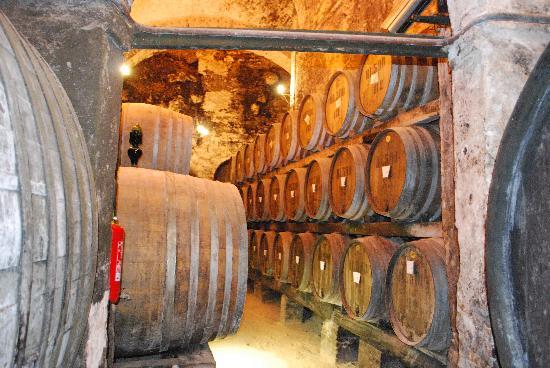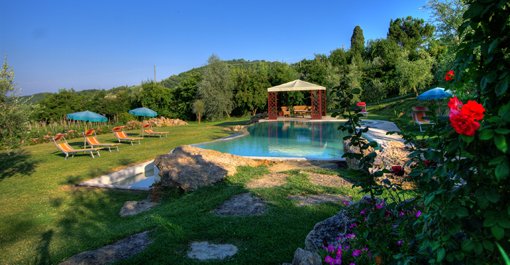Products wines
Montepulciano and fine quality wine: an indissoluble blend with deep roots in history.
This small area of south-east Tuscany is the birthplace of outstandingly prestigious wines. Its extraordinary wealth of artistic heritage and stunning landscape where the beauty of nature blends with the architecture of the town, unchanged since the 16th century, making this a truly blessed area. Wine, like other fruits of the work and ingenuity of mankind, did not appear in Montepulciano by chance: in fact, many are convinced that the opposite is true - it is thanks to the features and culture of this area and its profoundly developed civilisation, careful to protect and promote its heritage of skills and experience, that a prestigious drink like "Nobile" was able to evolve.
Montepulciano’s history has always been closely linked to the fame of its vineyards and wine.
An ancient legend claims that Montepulciano was founded by the Etruscan king Lars Porsenna, who is said to have moved from Chiusi onto the ancient hill of Mons Mercurius, followed by the people of Chiusi who later changed the name of the hill to Mont Politicus. Since its far-off origins Montepulciano’s history has been linked to wine, as demonstrated by a cylix (wine cup) decorated red figures, discovered with many bronze items in 1868 in an Etruscan tomb near the Tuscan town and produced in Chiusi. The cup depicts the image of Flufluns, the Etruscan version of Bacchus, the god of wine, playing with a maenad at cottabus, a game in which wine plays a leading role.
In his “Histories” (V,33), Livy describes how the Gauls were attracted to Italy for the wine from these hills which an Etruscan from Chiusi, named Arunte or Arrunte, had let them taste to convince them to cross the Alps enabling him to obtain revenge for his Locumone, over a question of jealousy.
The oldest documented reference to the wine of Montepulciano is from 789: the cleric Arnipert offered the church of San Silvestro or San Salvatore at Lanciniano on Mt Amiata, a plot of land cultivated with vineyards in the estate of the castle of Policiano. Later, Repetti mentions a document in 1350 (in his “Historical and Geographical dictionary of Tuscany”) which drew up the terms for trade and exportation of Vino Nobile di Montepulciano.
That the vineyards of Mons Pulitianus produced excellent wines has been documented since the late Middle Ages and in the mid-16th century Sante Lancerio, cellarman to Pope Paolo III Farnese, defined Montepulciano as “perfettissimo tanto il verno quanto la state odorifero, polputo, non agrestino, né carico di colore, sicchè è vino da Signori” - suitable for noble tables, although the earliest labels describe it as simply Rosso Scelto di Montepulciano.
From the Middle Ages to the 17th century, Francesco Redi - not only a doctor and naturalist but also a poet - praised this wine highly in his dithyrambic "Bacco in Toscana" of 1685. In this piece Redi imagines Bacchus and Ariadne praising the best wines of Tuscany:
Bella Arianna con bianca mano
versa la manna di Montepulciano,
colmane il tonfano, e porgilo a me.
Questo liquore, che sdrucciola al core,
oh, come l'ugola e baciami e mordemi!
oh, come in lacrime agli occhi disciogliemi!
Me ne strasecolo, me ne strabilio
e fatto estatico vo in visibilio.
Onde ognun che di Lieo
riverente il nome adora,
ascolti questo altissimo decreto,
che Bassareo pronuncia e gli dia fé:
Montepulciano d'ogni vino è Re!
The poem met with great success and passed from one Royal court to another, at last falling into the hands of William III of England, Scotland and Ireland. Perhaps William’s preference for this wine is due to Redi himself and the fame his writings brought Tuscan wines. We have proof of this in the journey of an English delegation in 1669 to the Grand Duchy of Tuscany to purchase Moscadello di Montalcino and Vino Nobile di Montepulciano for the English court.
This wine’s history continues, surrounded by high praise, through to the 19th century with the success of some wineries in leading mid-century contests, but also a severe judgment from Her Majesty’s winemaker during the Vienna Exhibition of 1873 – he complained about the single example of Montepulciano present, which was so mediocre in quality as to question the significance of Redi’s commendations.
In the early 20th century Vino Nobile di Montepulciano seemed to be relegated to the past, until the first exhibition of typical local wines held in Siena in 1933, organized by the Ente Mostra-Mercato Nazionale for typical prestigious wines. On this occasion the Cantina Fanetti, which is among those still active in Montepulciano today, presented a prestigious red wine which was highly praised. Other wineries followed this example and in 1937 a cooperative winery was founded with the aim of creating a sales structure for wine produced also by small-scale growers. Most of the wine produced was Chianti, with small quantities of Nobile. However, today the cooperative mainly produces and bottles Vino Nobile.
The Sixties brought a reawakening in winegrowing geared principally towards the production of Vino Nobile rather than Chianti. State and EU funds used by the wineries to convert their vineyards into conformity with the requirements of the DOC (1966), enabled new wineries to enter the market.
Recognition of DOCG status came in 1980 and Vino Nobile began a new life. In addition to this, the Rosso di Montepulciano DOC was created to define the terms of yield per hectare, alcohol content and ageing, although the production zone remains the same. Individual producers were given the option to join one of these two DOCs according to the aspect of their land, the seasonal weather trend and all the other elements which may affect the suitability of the grapes used for the production of one or the other of these wines. Montepulciano’s glorious past and its links to the local terroir, its history and the Vino Nobile remain essential elements in order to guarantee present and future quality and authenticity to all that this “noble land” can yield.
VINO NOBILE DI MONTEPULCIANO
On 12th July 1966, three years after the issue of the Denominazioni di Origine law, the President of the Republic issued a Decree which recognised the Denominazione di Origine Controllata (D.O.C.) “Vino Nobile di Montepulciano”, and prescribed the regulations for its production.On 1st July 1980 the “Nobile” became the first Italian wine to display the neck-strip of the Denominazione di Origine Controllata e Garantita (D.O.C.G.) which places it alongside the most prestigious wines in Italy and the world. The first series of “neck-strips” has been kept in Montepulciano at the Consorzio del Vino Nobile.
According to the current production regulations (Ministerial Decree of 9th November 2010) the basic features of Vino Nobile di Montepulciano are as follows:
- grape variety: Sangiovese, called “Prugnolo Gentile” at Montepulciano, minimum 70% may be joined up to 30% by other varieties authorized for the Tuscany Region.
- maximum permitted yield per hectare is 80 quintals with an effective yield in wine of 70%
- the wine can only be sold after ageing for two years (three for the Riserva) and in any case after passing a series of chemical and organoleptic tests carried out by a ministerial board.
- vinification and ageing must by law take place in the municipal area of Montepulciano.
ROSSO DI MONTEPULCIANO D.O.C.
According to the current production regulations (Ministerial Decree of 9th November 2010) Rosso di Montepulciano Doc is a relatively young wine rich in surprises and distinctive quality features. The production zone and grapes used are identical to the Nobile: Sangiovese, called “Prugnolo Gentile” at Montepulciano, minimum 70% may be joined up to 30% by other varieties authorized for the Tuscany Region. Its typical characteristics are the freshness of a youthful wine alongside the elegance of “Prugnolo Gentile”, making this wine excellent value for money and ideally served with local dishes. The Rosso di Montepulciano is a perfect accompaniment for traditional Tuscan first courses, and its features are especially enhanced by meat sauces as well as cured meats and local cheeses. Fine quality at fair prices for a wine which is becoming the battlehorse for Montepulciano production.
VIN SANTO DI MONTEPULCIANO D.O.C.
It is the niche product for many wineries, tracing the oldest tradition, the simple country actions innate in its character. It is Vin Santo di Montepulciano, the third (but not in order of importance) of the “Nobile” area.
Once called the “wine of hospitality”, it was used to warm up a passing stranger on his way down from the hills, celebrate some happy event, or make a toast on a Sunday after a special meal. Today, Vin Santo is slowly making its way back to a leading role for many wineries in Montepulciano who continue to produce it with impressive results.
The production specifications for Vin Santo di Montepulciano date back to 1996 although it has centuries of tradition. According to the current production regulations (Ministerial Decree of 9th November 2010) there are three distinct designations: Vin Santo di Montepulciano, Vin Santo di Montepulciano – Riserva, Vin Santo di Montepulciano – Occhio di Pernice. The first two use Malvasia Bianca, Grechetto bianco (called “Pulcinculo” in Montepulciano), and Trebbiano toscano grapes. The specifications do not accept the use of aromatic varieties or grapes that are not grown in the province of Siena. The “Occhio di Pernice” has a different combination of varieties: a minimum of 50% Sangiovese with other varieties grown in the terroir.
The traditional fermentation method is extremely typical: the harvested grapes are selected with the greatest care and hung up to dry in temperature- and humidity-controlled rooms. Drying makes it possible to obtain the sugar level necessary to make the wine. According to the specifications the grapes must be pressed from the 1st December for Vin Santo di Montepulciano and minimum from the 1st of January for the other tipology and then aged in wooden barrels (caratelli) with a minimum capacity of 75 litres for the Occhio di Pernice and maximum of 300 litres (Vin Santo di Montepulciano). The ageing period lasts for at least 3 years for the Vin Santo di Montepulciano, 5 years for the Riserva and 6 for the Occhio di Pernice.


















